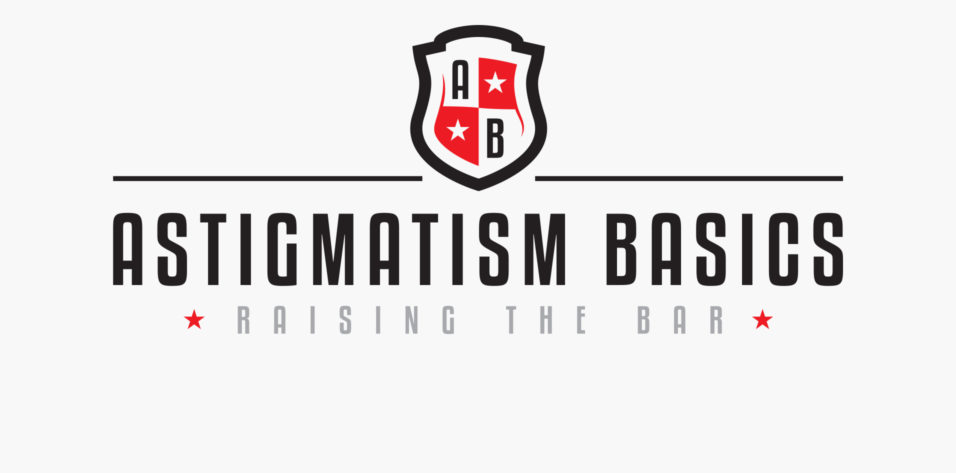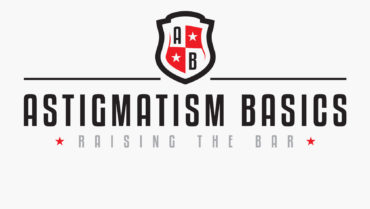Editorially independent content supported with advertising from

Video. Elizabeth Yeu, MD, weighs in on the importance of astigmatism management and shares what’s in store for Astigmatism Basics.
A Winning Strategy
By Michael Patterson, DO

When it comes to toric IOLs, diagnostic technologies are a key element to their successful use. However, it is equally as important to have a strategy for educating patients, tackling post–refractive surgery eyes, and accepting that enhancements are a reality, even for the most experienced surgeons. Below is an overview of my preferred calculation methods for toric IOLs as well as some tips for their overall optimization.
METHODS OF CHOICE
Preoperatively, I obtain an OPD III scan (Marco) for every patient. This topographer provides me with the patient’s Placido disc images, coma, trefoil, spherical aberrations, and other metrics that can be used to determine the toricity of the cornea. I usually use the axis determined by the OPD III as well. One feature I love about this technology is the ability to show a patient his or her vision without a toric lens versus with a toric lens; this adds “real-life” value to the desire of toric IOLs.
I obtain my biometry measurements from the IOLMaster 700 (Carl Zeiss Meditec) and then run the Barrett Toric calculator (http://ascrs.org/barrett-toric-calculator) with the IOLMaster 700 keratometry (K) readings. Occasionally, I utilize a manufacturer’s calculator, such as those from Johnson & Johnson Vision, Alcon, and Bausch + Lomb, as I use all of their toric lenses. However, I almost always go back to the Barret Toric Calculator, utilizing the swept-source biometry to measure the total keratometry (TK) from the IOLMaster 700.
Any time I run into an error or if there is disagreement between devices, I repeat my measurements. If a Placido disc image shows an abnormality of the tear film, I bring the patient back in and treat with artificial tears, maybe even a steroid. I will even repeat the measurements two to three times to ensure that they are symmetric and accurate.
In the OR, I use the Callisto Eye markerless system (Carl Zeiss Meditec). The markings from the IOLMaster 700 are put into my microscope reticle, so I see through my microscope exactly what the image was while the patient was seated in an upright position and know exactly where to put my axis without any markings on the eye. This eliminates any concern of cyclorotation when the patient is in the supine position in the OR. It also allows me to avoid using markers that smear on the cornea during surgery.
POST–REFRACTIVE SURGERY EYES
It is vital to address and treat the ocular surface in all post refractive surgery eyes, as the tear film will be abnormal. I also typically require that contact lens usage be stopped for several weeks before surgery. When it is time to proceed with cataract surgery in these eyes, I run my IOL calculations using the designated calculator on the ASCRS website (www.IOLcalc.ascrs.org). For previous RK patients, I select a refractive target of -0.75 D to -1.00 D, knowing that they will have hyperopic drift. For patients with a history of routine LASIK or PRK, I target -0.25 D.
PEARLS FOR ADOPTION
Young surgeons looking to implement toric IOLs should have access to a topographer and a biometer (IOLMaster or Lenstar [Haag-Streit]). It is important to ensure that every patient’s tear film is healthy before proceeding with surgery. So, first, optimize the ocular surface and, second, obtain good topography and biometry. If you can do that, you can utilize toric IOLs.
However, prepare yourself, as you will have to re-rotate lenses in the OR. This is a perfectly normal part of IOL surgery. The lens rotates and moves; it is floating in fluid, not screwed in place. And I am comfortable having this discussion with my patients. I tell them that 15% of patients need a touch-up (although the rate is not actually that high). Then, if they do need their lenses rotated after surgery, they’re not upset with me because they were adequately prepared.
I would also advise young surgeons starting out with toric IOLs to use them in clear-cut cases. I’m a big fan of going slow and steady. Make sure you have the procedure down pat, with symmetric stigmatism that looks normal, before tackling the complex cases such as post–refractive surgery eyes. Otherwise, you risk running into an unhappy patient who you are not yet prepared to manage. Set realistic expectations for yourself, and do not take complex cases early on.
Further, prepare yourself for longer chair time with these cases. Toric IOL patients are paying out of pocket for a premium technology, and they understandably expect a detailed conversation with their surgeon. Additionally, have an enhancement strategy, and make sure you’re willing to rotate the lens or touch it up however needed.
Last, if possible, become familiar with the different toric IOLs available. You will inevitably encounter a patient who has had a contralateral eye operated on by an outside surgeon. Whenever patients are referred to me, I prefer to have experience with the lens utilized in their first operated eye, and I have therefore made a point to gain experience with multiple toric IOL technologies.
Intraoperative Aberrometry in Practice
By William F. Wiley, MD

My practice was early in the adoption of intraoperative aberrometry (ORA System, Alcon). Our first cases were done when the device could be used only in the pseudophakic status; it was not quite enabled to provide aphakic predictions. Since then, intraoperative aberrometry technology has evolved greatly, and it offers numerous benefits. The driving point that pushed us to adopt the technology was the desire to gain confidence in providing premium IOLs and to reduce the chance of outlier results.
Biometry has come a long way over the past 10 years. However, even with these advances, there was room to improve results—in particular, to reduce postoperative astigmatism. We lacked a method for truly measuring the amount of total corneal astigmatism. With intraoperative aberrometry, the surgeon has the ability to measure the actual astigmatism (not just predict it) and the total corneal astigmatism power after the main incisions are made; thus, these measurements can be accounted for when choosing the proper IOL power.
LEARNING CURVE
There is a learning curve with intraoperative aberrometry. I tell people that it is like using a high-tech digital camera—you must control the variables that could affect image capture. That means controlling IOP when capturing images and ensuring that the eye is as close to a physiologic state as possible. To work through the learning curve, I used intraoperative aberrometry in every case (even traditional IOLs) to grow my confidence in the technology for use in challenging or more demanding premium cases.
For young surgeons looking to adopt intraoperative aberrometry, I recommend exercising patience when working through the learning curve and utilizing intraoperative aberrometry on all-comers for a period of time to gain confidence for its use in more demanding cases. Be mindful of intraoperative variables such as IOP and surface hydration and aim to capture images when the variables are optimally controlled.
AREAS OF USE
Currently, I use intraoperative aberrometry for all of my upgraded patients, patients with prior refractive surgery, and any cases in which I had questions about the traditional biometry. In regard to premium technology, patients are looking for decreased dependence on glasses, and I will employ any device that gives me an edge in reducing postoperative refractive errors. Studies have shown that intraoperative aberrometry can reduce the chance of refractive error of ±0.50 D by more than 50%.1,2
Intraoperative Aberrometry AND IOLS
I will not place a toric IOL without using intraoperative aberrometry. I have found intraoperative aberrometry to be crucial in three main areas of toric IOL usage. It helps with cylinder power choice, cylinder axis position, and base sphere power. Our percentage of toric IOL implantations increased after the introduction of intraoperative aberrometry, which I attribute to increased confidence of discussing astigmatism correction among surgeon, staff, and referring doctors.
Additionally, I have experience utilizing intraoperative aberrometry and the Light Adjustable Lens (LAL, RxSight) during clinical studies. I believe there will be a place for intraoperative aberrometry after the LAL is available. Even with the LAL, there is a likely optimal starting refraction point of adjustment, depending on other considerations specific to that eye (previous refractive surgery, spherical aberration, etc.). Intraoperative aberrometry may be useful to set the eye up for optimal adjustment results in the postoperative period.
1. VerifEye+ Technology. Alcon data on file.
2. Ianchulev T, Hoffer K, Yoo S, et al. Intraoperative refractive biometry for predicting intraocular lens power calculation after prior myopic refractive surgery. Ophthalmology. 2014;121(1):57-60.


